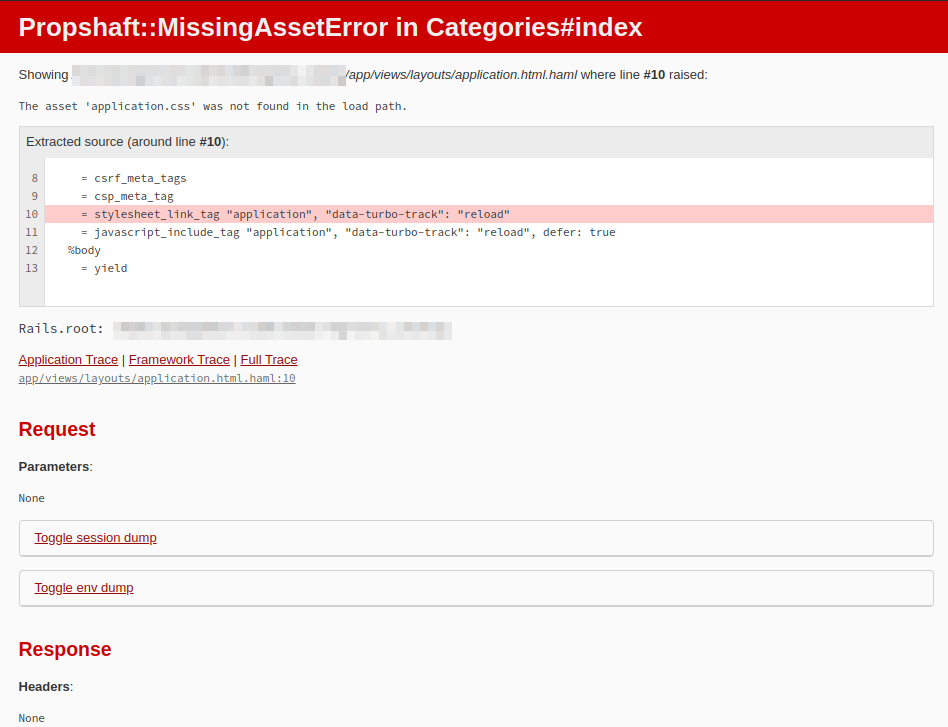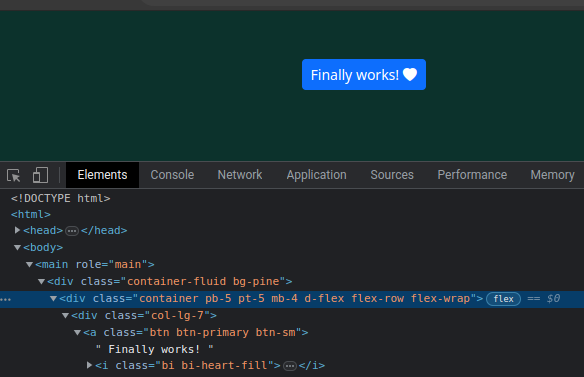Adventures with rails/sprockets -> rails/propshaft
📆: 2023-09-15 - 🏷: blog, ruby-on-rails, propshaft, assets
Join me in this review of my day debugging an asset pipeline rewritten from Sprockets to Propshaft for the 3rd time.
So my day starts the following screen:

And a colleague saying:
I’m stuck with the asset pipeline, do you have time to have a look?
— @colleague, sick of dealing with the asset pipeline
How does an asset pipeline works? [roughly*]
A lot of what’s below here is my own understanding of how things work, to get a full overview you can always read the rails guide on assets pipeline
It all starts with sources. Asset sources are artifacts that may need to be processed in some way to result in a CSS File, JS File, SVG, whatever a browser can understand/render/execute.
The easiest “asset pipeline” we can think of is just: not having to process anything. Just have your application code render locations of your assets that the webserver can serve and boom, call it a day.
But as the world progresses, Front-end technologies get progressively complicated and involve a bunch of moving parts.
In the current day an asset pipeline usually has two sides:
-
A Javascript Transpiler1: A piece of software that will transform isolated pieces of code into one, or many, big javascript entrypoint file to be served to the browser.
Note the use of “pieces of code” because JS can also be written in… something else! Like in the old days when people used to write CoffeeScript. Although now Typescript the go-to choice (depending on whom you ask of course).
The main goal is to have JS files that the browser can understand.
-
A CSS Processor: Much like the JS Transpiler, this converts sources into CSS files. A popular choice is to use
sass. But as usual, it’s a matter of taste.The main goal is to have CSS files that the browser can understand.
A quick summary here:
After the sources have been converted into understandable artifacts by the browser, then comes another pretty critical piece of the process we need to understand: The Assets Manifest.
A tale of the before times
You see, in ze good ol’ days, there was a folder where you dumped all your CSS/JS, make sure your webserver can serve it and referred to it in the HTML. Done deal, izi-peezy.
Nowadays there’s many many many moving parts involved into this. Not only processing and serving them, but nowadays there’s a bunch of caches involved (browser cache, CDN cache, etc.). We’ll focus on a technique that’s enabled by default: Asset Fingerprinting
To be short in this long-ass journey, Asset Fingerprinting is the process of: Generating a unique filename per asset that changes if the assets contents also changes.
That usually means: calculate a digest of the contents, append it to the filename and keep track of it somehow.
The problem now is that you have a bunch of random filenames like:
Poppins-Medium-85f225b62f54abf64418686830908d2e.ttf
Poppins-Medium-564476dfea32cf397f470e5dd607ed42.ttf
Poppins-Medium-3a41c57c68c387a88540df1125eb7f01.ttf
That’s not quite intuitive to write in source code…
To solve this issue, a manifest is usually employed. This asset manifest is in essence a dictionary: You look for a source name, and you get the digest-appended name.
[Human-readable-name] -> [Name-with-Digest]
Poppins-Medium.ttf -> Poppins-Medium-3a41c57c68c387a88540df1125eb7f01.ttf
Even though there are 3 versions of Poppins-Medium.ttf, only one is kept in the manifest, that we will consider as the appropriate one. How this is computed is a bit besides the point of this journey.
Translating all these details to rails terms:
- JS:
esbuildcollects all JS Module-style entrypoints into a ready-to-execute single-filejsentrypoints. - CSS:
sasscollects allsass/scssfiles into ready-to-rendercssfiles. - Asset Processor: rails/propshaft.
JS & CSS compilation run with yarn outside of rails. They output things to app/assets/builds.
Then rails/propshaft will process all foreign references and cross-match them with the assets it finds
in the “load paths” (spoiler alert: Rails.application.config.assets.paths), and the result
Coming back to the rails problem at hand, let’s dig deeper into the rails issue, now that we understand a bit the whole asset pipeline shenanigans.
Some debugging later, we get this screen:

Now we get a “prettier” error, we can see a “cause”.
The asset 'application.css' was not found in the load path.
Aha, we’re getting somewhere, so application.css is not found by the rails application… How does rails “finds” assets then?
From the app backtrace we can see:
stylesheet_link_tag "application", "data-turbo-track": "reload"
stylesheet_link_tag must be looking up application.css somewhere, and it doesn’t find it.
My buddy had cleared all possible customizations from the ruby code, it’s all defaults in a desperate effort to make this work.
What are the defaults? Time to source code!
After a quick visit to rails/propshaft’s railtie:
Rails::Engine.initializer "propshaft.append_assets_path", group: :all do |app|
app.config.assets.paths.unshift(*paths["vendor/assets"].existent_directories)
app.config.assets.paths.unshift(*paths["lib/assets"].existent_directories)
app.config.assets.paths.unshift(*paths["app/assets"].existent_directories)
app.config.assets.paths = app.config.assets.paths.without(Array(app.config.assets.excluded_paths).collect(&:to_s))
end
The default paths are vendor/assets, lib/assets, app/assets and all its descendants. And surely enough, we found the issue.
My buddy just tried to make it work like the Sprocket times, and made changes to
the package.json that were obscure to us at the time, but it looked like:
- "build:css": "sass ./app/assets/stylesheets/application.scss:./app/assets/builds/application.css --no-source-map --load-path=node_modules",
+ "build:css": "sass ./app/assets/stylesheets/application.scss:./public/assets/application.css --no-source-map --load-path=node_modules",
- "build": "esbuild app/javascript/*.* --bundle --sourcemap --outdir=app/assets/builds --public-path=assets"
+ "build": "esbuild app/javascript/*.* --bundle --sourcemap --outdir=public/assets --public-path=assets"
By outputting to ./public/assets instead of the default-known path: /app/assets/, now propshaft couldn’t find the resulting CSS file from the sass build.
So we decided to allow propshaft read the public/assets directory, where the yarn tasks were outputting the results…
# in the initializer
Rails.application.config.assets.paths << Rails.root.join("public/assets")
Foreshadowing: that was a bad idea, very bad idea.
We didn’t see the original error anymore, the application booted successfully and rendered… But the output of the assets:precompile task started showing some odd stuff.
Writing rails_admin/custom/mixins-911875cdfd5191767b7b7ef80e1d45e25a87d32e-cb22d660bb3d9a6878dca29ed218770bf64b35e7-cb22d660bb3d9a6878dca29ed218770bf64b35e7-cb22d660bb3d9a6878dca29ed218770bf64b35e7-cb22d660bb3d9a6878dca29ed218770bf64b35e7-cb22d660bb3d9a6878dca29ed218770bf64b35e7.scss
[...]
Errno::ENAMETOOLONG: File name too long @ rb_sysopen - [...snip...]/public/assets/rails_admin/custom/mixins-911875cdfd5191767b7b7ef80e1d45e25a87d32e-cb22d660bb3d9a6878dca29ed218770bf64b35e7-cb22d660bb3d9a6878dca29ed218770bf64b35e7-cb22d660bb3d9a6878dca29ed218770bf64b35e7-cb22d660bb3d9a6878dca29ed218770bf64b35e7-cb22d660bb3d9a6878dca29ed218770bf64b35e7.scss
That’s way too long for a useful filename, something is off. Let’s parse that long filename:
hash1=911875cdfd5191767b7b7ef80e1d45e25a87d32e
hash2=cb22d660bb3d9a6878dca29ed218770bf64b35e7
rails_admin/custom/mixins-[hash1]-[hash2]-[hash2]-[hash2]-[hash2]-[hash2].sss
Member when times were simpler? Asset fingerprinting explanation
Asset fingerprinting adds a digest to the end of the basename of the file. And because we added public/assets to the lookup paths of propshaft, every asset there is processed, digest is calculated and appended to the filename.
Our “solution” worked, it worked… too well. So that’s why the app/assets/builds directory exists! It’s a “staging area” of the compiled sources yet-to-become-assets for propshaft to collect and place in the output assets directory public/assets and build a manifest afterwards.
But app/assets/builds is such a weird choice for this, app/ is meant to be
source files, now it has compilation results? We weren’t that amazed at this fact…
We inclined to use tmp/assets to save the result of the yarn tasks, that way won’t:
- be in
app/, compilation results are not source code. - not collide with asset fingerprinting and generate long-long-long filenames.
And surely enough, after:
# in the initializer
Rails.application.config.assets.paths << Rails.root.join("tmp/assets")
Compilation worked, no digest of a digest of a digest file paths but… it wasn’t quite done.
After inspecting the resulting CSS we noticed that blocks of scss were working just fine, like:
@font-face {
font-family: "Poppins";
src: url("/Poppins-Medium.ttf") format("truetype");
font-weight: 500;
font-style: normal;
}
Was transpiled to:
@font-face {
font-family: "Poppins";
src: url("/assets/Poppins-Medium-95f2263e7bdb88c3d120ee2cd60394a2c694f7a7.ttf") format("truetype");
font-weight: 500;
font-style: normal;
}
But…
// [...] snipp snipp [...]
$bootstrap-icons-font-src: url("bootstrap-icons/font/fonts/bootstrap-icons.woff2") format("woff2"), url("bootstrap-icons/font/fonts/bootstrap-icons.woff") format("woff") !default;
@import 'bootstrap-icons/font/bootstrap-icons';
// [...] snipp snipp [...]
Was transpiled to:
@font-face {
font-display: block;
font-family: "bootstrap-icons";
src: url("bootstrap-icons/font/fonts/bootstrap-icons.woff2") format("woff2"), url("bootstrap-icons/font/fonts/bootstrap-icons.woff") format("woff");
}
It’s clear that the scss -> css process works fenomenaly, variable was correcly interpolated. But the asset processor should’ve picked that location up and translated the url, so it has the [digest] just before the extension.
Furthermore, the logs also show:
Unable to resolve 'bootstrap-icons/font/fonts/bootstrap-icons.woff' for missing asset 'bootstrap-icons/font/fonts/bootstrap-icons.woff' in application.css
That’s an indication there, when CSS url function refers to something not existing it will be kept as-is and log an error in the task output.
Now the question is: how to make propshaft aware of that path?
You guessed it: More paths in the initializer.
The $bootstrap-icons-font-src says the bootstrap-icons fonts are in bootstrap-icons/font/fonts, that’s relative to node_modules, so in theory… font’s should exist in node_modules/bootstrap-icons/font/fonts.
ls -1 node_modules/bootstrap-icons/font/fonts
bootstrap-icons.woff
bootstrap-icons.woff2
Cool, now I guess we can just add that path, and propshaft knows where to find things.
Rails.application.config.assets.paths << Rails.root.join('node_modules/bootstrap-icons/font/fonts')
And surely enough, it shows up in the logs:
Writing bootstrap-icons-f8b71410af9b67092d6fc3f72d4756b9e9a2cf7a.woff
But the “unable to resolve” message below persists:
Unable to resolve 'bootstrap-icons/font/fonts/bootstrap-icons.woff' for missing asset 'bootstrap-icons/font/fonts/bootstrap-icons.woff' in application.css
Time to dig deeper, what’s that Rails.application.config.assets.paths for? And as usual with rails… source code is the way to go.
We want to know how’s bootstrap-icons is being referred in the manifest. After spending a significant amount of time going around the source code, here are the important facts to get to the bottom of this:
Rails.application.config.assets.pathsends up being used and distributed through the project in rails/propshaft’sPropshaft::Assembly.- The assets manifest is not longer configurable (as it was in sprockets).
Rails.application.config.assets.output_pathwhen not defined defaults to:public/assets, which is important becausePropshaft::Processor::MANIFEST_FILENAMEis relative to that path.
With the manifest at hand, let’s see what we can find there:
jq < public/assets/.manifest.json | grep 'bootstrap-icons'
"bootstrap-icons.woff": "bootstrap-icons-f8b71410af9b67092d6fc3f72d4756b9e9a2cf7a.woff",
"bootstrap-icons.woff2": "bootstrap-icons-a76c0fb01876e9f9abd10fe5c48d6da20c3bb09d.woff2",
Aha! We’re referring to them with a long path bootstrap-icons/font/fonts/bootstrap-icons.woff2, but they’re actually reported in the manifest as bare files: bootstrap-icons.woff2.
This means all assets referred are relative to any directory specified in: Rails.application.config.assets.paths. Probably collisions are settled by order in the array (first path matched is returned).
Let’s change that path line then to:
Rails.application.config.assets.paths << Rails.root.join('node_modules')
It should not harm… right…. RIGHT??? Spoiler alert: it does.
I’m not even going to put the full output, but suffice to say, it found shit:
jq < public/assets/.manifest.json | grep 'bootstrap-icons' | wc -l
1962
jq < public/assets/.manifest.json | grep 'bootstrap-icons.css'
"bootstrap-icons/font/bootstrap-icons.css": "bootstrap-icons/font/bootstrap-icons-bcd28b803d6d96d863de260eef795aa785c2566d.css",
The asset pipeline captured pretty much anything inside node_modules directory, and its descendants, including but not limited to these funny examples:
jq < public/assets/.manifest.json | egrep -v '(css|js|svg)": '
# symlinks
".bin/esbuild": ".bin/esbuild",
".bin/sass": ".bin/sass",
# json files
"@babel/runtime/helpers/esm/package.json": "@babel/runtime/helpers/esm/package-2237ea82636a9a3ddf91b9bcef28daef5428aaa1.json",
# licenses
"@babel/runtime/LICENSE": "@babel/runtime/LICENSE",
# typescript files
"rails_admin/node_modules/@popperjs/core/lib/utils/mergeByName.d.ts": "rails_admin/node_modules/@popperjs/core/lib/utils/mergeByName.d-0989b4fc247b6bfc84d5c6487f5115c5123cf118.ts", # I'm sure certain rails contributor loves these files in particular
# flow files
"rails_admin/node_modules/@popperjs/core/lib/utils/mergeByName.js.flow": "rails_admin/node_modules/@popperjs/core/lib/utils/mergeByName.js-ed925a99a06036e670f2e060da4f2a4591fefb68.flow",
There’s no pretty solution to this, as usual. The main issue is that we’re working on a path-based logic. Anything in that path will be included or excluded. You don’t get file-specific include/exclude filters.
With that said, we settled on:
Rails.application.config.assets.paths << Rails.root.join("node_modules/bootstrap-icons/font")
With it, the resulting manifest looks like:
jq < public/assets/.manifest.json | grep 'bootstrap-icons'
"fonts/bootstrap-icons.woff": "fonts/bootstrap-icons-f8b71410af9b67092d6fc3f72d4756b9e9a2cf7a.woff",
"fonts/bootstrap-icons.woff2": "fonts/bootstrap-icons-a76c0fb01876e9f9abd10fe5c48d6da20c3bb09d.woff2",
"bootstrap-icons.json": "bootstrap-icons-be63c3b0cc95f7496368e195843792a11c913468.json",
"bootstrap-icons.css": "bootstrap-icons-bcd28b803d6d96d863de260eef795aa785c2566d.css",
"bootstrap-icons.scss": "bootstrap-icons-abeb873a2c816f4ff54d00148e865192c8a778cd.scss",
It’s… good enough tbh, not bare files, not quite as namespaced as I’d love to but we gotta work under with the constraints.
The final step would be checking that propshaft actually
replaced the wrong url.
So we adjust our snippet to:
$bootstrap-icons-font-src: url("fonts/bootstrap-icons.woff2") format("woff2"), url("fonts/bootstrap-icons.woff") format("woff") !default;
@import 'bootstrap-icons/font/bootstrap-icons';
And we get… 🥁🥁🥁
@font-face {
font-display: block;
font-family: "bootstrap-icons";
src: url("/assets/fonts/bootstrap-icons-a76c0fb01876e9f9abd10fe5c48d6da20c3bb09d.woff2") format("woff2"), url("/assets/fonts/bootstrap-icons-f8b71410af9b67092d6fc3f72d4756b9e9a2cf7a.woff") format("woff");
}
FINALLY works!

And that was only ONE day of debugging an asset pipeline, I hope I don’t have to jump into this again tbh.
-
Nobody likes the term Transpiler anymore, to me: if the output of the compiler still can’t be used by the end-result we’re transpiling and not compiling. ↩